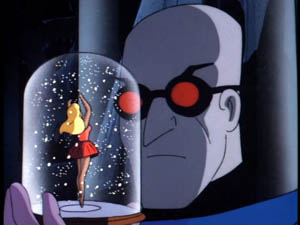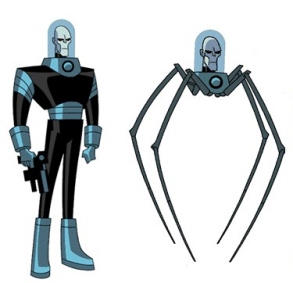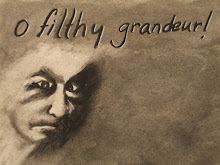So, I got the complete Batman the Animated Series on DVD for xmas, and have thus become nostalgically obsessed with it. As usual, I couldn't turn my feminism off, and so I analyzed my favorite childhood cartoon.
But first, I would like to point out that what I love most about the series is that it's pretty dark for a "kids" show (though in the special features section of the DVDs, it is stated that this is not a kids show). The animation has that fifties "film noir" appearance, and is clearly influenced by the Burton Batman movies.
Gender
There are clear divisions of masculinity and femininity. There's Bruce Wayne/Batman, and in case you've been under some sort of rock, Bruce Wayne uses the Batman identity to fight crime, spurred by the death of his parents. As a millionaire playboy, he runs his company as a successful, handsome and much-desired businessman. The men respect him, and the ladies want him. As Batman, he's a nocturnal ass-kicker fighting for justice. He is smart, seemingly indestructible, and ripped.
Dick Grayson/Robin, is similarly masculine, though less-so than Batman (since apparently masculinity can be measured). Batman is the leader, and being the "boy-wonder" automatically lands you in second place in masculinity. He's a crime-fighting college boy. His masculinity is especially apparent in the two-parter episode "Robin's Reckoning," where Robin finds the man responsible for his parents' murder. He must confront his desire for revenge, and his anger at Batman attempting to protect him.
No cartoon about crime-fighting is complete without the femme fatale, and in Gotham City, there are plenty. Poison Ivy, Catwoman, Harley Quinn, Red Claw, Talia--all are sexualized curvaceous women who at some point cross Batman. They epitomize female sexuality as a weapon that makes men weak. And, while the women don't show too much skin, their costumes do not leave much of anything to the imagination, most appearing to be a second skin.
Indeed, even their gimmicks are gendered: Poison Ivy is an environmentalist, fighting for plants--nature of c ourse being a feminine symbol which she embraces. Catwoman personifies the femininity of felines, and is an avid activist for animal rights--and lives alone with her cat, Isis. Harley Quinn is the ditsy girlfriend/sidekick to the Joker, and on more than one occasion she teams up with Poison Ivy to go on a crime spree that demonstrates their power as women in a Thelma-and-Louise fashion, boasting that no man can take them, thereafter getting arrested by the token woman officer, Montoya (in "Harley and Ivy." Please also note that Montoya is the token Latina, a character added by the creators of this cartoon to "diversify" Batman's world, as stated in the special features). The second time Harley and Poison Ivy team up, they are joined by Livewire later in the series in "Girls Night Out" where they kidnap Bruce Wayne to go on a shopping spree (because even sociopathic criminals can't resist the mall if they have vaginas).
ourse being a feminine symbol which she embraces. Catwoman personifies the femininity of felines, and is an avid activist for animal rights--and lives alone with her cat, Isis. Harley Quinn is the ditsy girlfriend/sidekick to the Joker, and on more than one occasion she teams up with Poison Ivy to go on a crime spree that demonstrates their power as women in a Thelma-and-Louise fashion, boasting that no man can take them, thereafter getting arrested by the token woman officer, Montoya (in "Harley and Ivy." Please also note that Montoya is the token Latina, a character added by the creators of this cartoon to "diversify" Batman's world, as stated in the special features). The second time Harley and Poison Ivy team up, they are joined by Livewire later in the series in "Girls Night Out" where they kidnap Bruce Wayne to go on a shopping spree (because even sociopathic criminals can't resist the mall if they have vaginas). As a child, I didn't relate to Batman or Robin, and Batgirl makes her appearance so late in the series that by then I was already idolizing Catwoman and Harley. Now that I reflect on that notion, it's admittedly frightening. While Catwoman may be a criminal, she's at least doing it for the animals, and she does kick some serious ass (well, all of them do I suppose, thus linking violence and sex, yet again). The character of Harley, is a little more disturbing, or at least her portrayal is. She is the Joker's girlfriend, sidekick, lackey, punching bag. He is constantly ordering her around, and punching her--all while she smiles and refers to him as "puddin." Sure, there are a few episodes where she turns on him, leaves him--but she always comes back--not out of fear, as would make sense in that sort of situation, but out of love. Not that that's unheard of or unrealistic, but if nothing else it does make her seem stupid, or silly. Sure, he batters her, but she loves him (I wonder where we learn victim-blaming?--hintity-hint-hint).
As a child, I didn't relate to Batman or Robin, and Batgirl makes her appearance so late in the series that by then I was already idolizing Catwoman and Harley. Now that I reflect on that notion, it's admittedly frightening. While Catwoman may be a criminal, she's at least doing it for the animals, and she does kick some serious ass (well, all of them do I suppose, thus linking violence and sex, yet again). The character of Harley, is a little more disturbing, or at least her portrayal is. She is the Joker's girlfriend, sidekick, lackey, punching bag. He is constantly ordering her around, and punching her--all while she smiles and refers to him as "puddin." Sure, there are a few episodes where she turns on him, leaves him--but she always comes back--not out of fear, as would make sense in that sort of situation, but out of love. Not that that's unheard of or unrealistic, but if nothing else it does make her seem stupid, or silly. Sure, he batters her, but she loves him (I wonder where we learn victim-blaming?--hintity-hint-hint).
This montage should give you some idea of the relationship between the Joker and Harley (though the song is sort of appropriate, it does get annoying; playing the video on mute gets the same idea across--I mean, you really don't need to know what the characters are saying. Also, 2 minutes 50 seconds in is particularly shocking considering this was on the WB--and we wonder why some little boys are so aggressive and grow up to think it's okay to hit women).
To contrast these "bad girls" there is of course Barbara Gordon, or Batgirl. Though she is also clad in skin-tight attire, she is not overtly sexual. She flirts, certainly, but she's a good girl--she's not waving her sexuality in any man's face, using it as a weapon, or making men weak.
Identity
I think what's also interesting about this show (and others depicting masked crime-fighters and criminals) is this idea of multiple identities. Characters generally have a primary identity and a secondary identity, i.e. Bruce Wayne as primary, Batman secondary (think Bill's lecture to Beatrice about Superman in Kill Bill Vol. 2). For the criminals, the primary identity is generally their criminal identity (not the rehabilitated-rejoining-society one, though in the Joker's case, he's got a singular identity). Others later become their primary identity, such as Two-Face, who is schizophrenic--the other personality taking over completely once he's maimed. Selena Kyle, is simultaneously Selena Kyle and Catwoman--I mean, at a certain point her identity becomes well-known once she's arrested, and thereafter her continuing to wear the Catwoman outfit on her late-night excursions is not necessary to hide her daytime identity--basically they're interchangeable. Harley Quinn's primary identity reflects the Joker's expectations of her, rather than her pre-Joker identity as Harlene Quinnzel.
Dehumanization
Toward the end of the series, the animation style changed to merge with the new Superman adventures, changing the overall look of the cartoon. As a result, there was a significant change in the appearance of certain characters, some more drastic than others. Bruce Wayne and the other good guys gained a more smooth texture--but the bad guys (and girls) were drastically altered.
Catwoman loses her curves (and apparently her skin color, especially compared to Nightwing's a.k.a. Dick Grayson): Poison Ivy similarly loses her color, and with this change, her appeal:
Poison Ivy similarly loses her color, and with this change, her appeal: Though the women are almost sickeningly pale, and have lost quite a bit of definition, they are still sexy, still embodying the femme fatale--still kind of human. Batgirl (see photo at bottom) did not alter drastically in the new series as the "bad girls" did--she still has skin pigmentation, and unlike Catwoman's new look, she's has eyes.
Though the women are almost sickeningly pale, and have lost quite a bit of definition, they are still sexy, still embodying the femme fatale--still kind of human. Batgirl (see photo at bottom) did not alter drastically in the new series as the "bad girls" did--she still has skin pigmentation, and unlike Catwoman's new look, she's has eyes.
The bad men, however, are a little further removed from being human.
The Scarecrow went from this: to this:
to this: Note that the first image is known to be a mask, since it is often removed once Batman captures the Scarecrow. The second image seems like it's actually his face--a disfigured face that isn't proven to be a mask, yet we don't have an origin for such a drastic shift. The unexplained noose around his neck conjures up its own repulsive imagery too, giving him a more horrifying appearance. This change removes him from humanity, monsterizing him.
Note that the first image is known to be a mask, since it is often removed once Batman captures the Scarecrow. The second image seems like it's actually his face--a disfigured face that isn't proven to be a mask, yet we don't have an origin for such a drastic shift. The unexplained noose around his neck conjures up its own repulsive imagery too, giving him a more horrifying appearance. This change removes him from humanity, monsterizing him.
We also have Victor Fries, also known as Mr. Freeze, who through an accident cannot survive unless he is in subzero temperatures. In the earlier episodes his aims are to make people as miserable as he is as revenge for the loss of his wife. Though a little extreme, his portrayal does elicit some sympathy--after all, he's human, and not without emotions.
But his new look strips him of humanity: In the episode "Cold Comfort," we learn that Mr. Freeze's body has died, and so he must rely on a robotic body to keep what's left of him alive. Note that his face looks more like a skull than a pale visage. Not only does he not look so much like a real person, he doesn't even have a body, dependent upon machinery for life and mobility.
In the episode "Cold Comfort," we learn that Mr. Freeze's body has died, and so he must rely on a robotic body to keep what's left of him alive. Note that his face looks more like a skull than a pale visage. Not only does he not look so much like a real person, he doesn't even have a body, dependent upon machinery for life and mobility.
What is important about these changes is that it removes the characters to some degree from being human, or at the very least in creating an "other." Variations of skin-tone is one way to achieve the "othering" process; notice that the men's skin is darker than the women, as in Nightwing's compared to Catwoman or Poison Ivy. Often in other forms of animation, bad men are darker than the good men. It is also known that dehumanization is the first step in justifying hostility toward another person or group of people. There are plenty of other examples of this in other t.v. shows and cartoons. What it boils down to is that it's easier to justify Batman beating the shit out of something that doesn't really look human. What further underscores this is that they're criminals who need to be brought to justice--might as well animalize them, disfigure them into monstrosities so it isn't that Batman is brutalizing and using excessive force on people--they're monsters that society fears and locks up.
There is a long history of "othering" in racist propaganda; in a so-called "post-racial" world, there are plenty of recent examples as well.
Phallic Imagery
One of the major characteristics of this show is the overcompensating Batmobile: This impractical design cannot possibly be that useful in a chase--particularly on those tight turns. While it is pretty impressive, one cannot deny that it's a huge penis. A huge, drivable penis.
This impractical design cannot possibly be that useful in a chase--particularly on those tight turns. While it is pretty impressive, one cannot deny that it's a huge penis. A huge, drivable penis.
Also, I argue that Batman's cape is also a phallic image, especially when compared to Batgirl's cape--though it could be said that hers is short so we can see her ass (to which I would argue I wouldn't mind seeing Batman's ass, but it wouldn't be so masculine if he had a short cape, would it?).
And if anyone accuses me of making a stretch on these arguments, there are quite a few "strange" things that are considered symbols for penises.
Monday, March 16, 2009
Batman the Animated Series--a look at gender, identity, and othering (and some stuff about penises)
Posted by FilthyGrandeur at 3/16/2009 10:21:00 PM
Labels: batman, batman the animated series, catwoman, gender, harley quinn, poison ivy, red claw, robin
Subscribe to:
Post Comments (Atom)


7 comments:
Great post! Really love how you deconstructed the shifts in character design throughout the series. I, too, identified more with Catwoman than with Batgirl. But I always found the conflation of "female villaine + overt sexuality" problematic, and it's always nice to see the Harley Quinn/Joker pairing picked apart (although I do enjoy the idea of the ship).
OMFG! i haven't really ever been a fan of the show. but i still can't get over the whole harley quinn and joker romance. and also that halrey quinn has six boobs hanging from her neck.
m.
@ M.
i totally noticed the boobs too! yay more body symbols!
I always thought that harleys relationship with the joker was meant to be disturbing. You could glue together a bunch of scenes of jokes about a crime that the joker is a part of and say that it makes crime acceptable, but that seems to be the opposite of what they are getting at. The joker is supposed to be disturbing and bad because he makes light of things that are horrible. I always felt really bad for harley.
As far as the new art style- i just thought that it was ugly when it first came out. I think it made everyone look less person like and it stripped the batman series of its old timey feel.
the shopping episode pissed me off as a kid even, but i guess holiday episodes are meant for stupid fluff. blech
Seriously? Six boobs hanging from her neck? Cape = penis?
There's logical conclusions, and then there's reaching.
You're going beyond "reaching" with this.
Who cares if the villains are dehumanized? They ARE monstrous. That's why they're comic book villains. For every overly-ridiculously-heroic hero, there's an overly-ridiculously-villainous villain.
@Anonymous--
I'm only leaving your comment up because i find it fucking hilarious.
yeah, they're boobs--and yeah, it's a dick. get the fuck over it.
Very late to the game I know, but I just stumbled onto this post and am watching the later episodes of the animated series on DVD at the moment.
While I agree with a lot of points made here, I would be remiss if I didn't point out a couple flaws.
1) Penguin becomes MORE human as the series develops, both in design and characterization.
2) At the same time, the Batmobile becomes less phallic.
3) Nightwing goes out on his own (the masculine culmination of leaving your "father" to forge your own path as a man) yet is entirely capeless. Curious where that places him in your masculine-o-meter, considering Batgirl and even tiny Robin has a cape, both essentially "bigger" than his.
Post a Comment